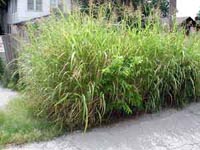Resource Library
Plant of the Week: Johnsongrass
The University of Arkansas System Division of Agriculture does not promote, support or recommend plants featured in "Plant of the Week." Please consult your local Extension office for plants suitable for your region.
Plant of the Week
Johnsongrass
Latin: Sorghum halepense

Drive any Arkansas roadway this time of year and you’ll see expansive stands of Johnsongrass, a weed so epidemic it is considered one of the nation’s ten worst.
Let us investigate this pernicious weed and meet Col. Johnson who was unfortunate enough to be remembered by the weed that ate the South.
Johnsongrass (Sorghum halepense) is a warm-season grass that forms large colonies from stout, finger-sized, much-branched rhizomes. A medium-sized plant can produce up to 60 feet of rhizomes in a single year.
From these rhizomes emerge a thicket of unbranched, pinkie-sized stems that grow 5 to 6 feet tall and are topped with a foot-long open panicle of flowers that are followed by purplish seeds. A medium-sized clump will produce two pounds of seed.
One of the first mentions of the weed, later to be called Johnsongrass, was in 1848 when a correspondent to the Southern Cultivator described a grass that had taken over the South Carolina plantation of Gov. John Means. One source says the seeds were mixed in with flax seeds the governor had imported from the Mediterranean region; another says that he ordered "guinea grass" from Turkey about 1835. Early names for the weed were Mean’s Grass and Guinea Grass.
Arkansas had a connection in the early spread of the plant. N.D. Smith of Washington, Ark., wrote that he had imported guinea grass seeds from Jamaica in 1842 for use as chicken feed. Not surprisingly, the crop flourished, and he reported cutting two tons of hay per acre from each of his four cuttings per year.
About this same time an Alabama planter named Col. William Johnson traveled to South Carolina and acquired seeds of Governor Mean’s grass and took it to his bottomland farm near Selma. Johnson freely shared seeds and, in a kind of thankless notoriety, the name Johnson Grass came into common usage shortly after the Civil War.
But, to really screw things up properly requires the long reach of the government. In 1873, the American consul in Kingston, Jamaica procured seeds of Guinea Grass for the Department of Agriculture. During this period the government - and especially congressmen - sent out millions of free seed packets to their constituents as a way of assuring they would be remembered favorably come election day.
I find no direct evidence that Johnsongrass seed was in this seed giveaway program, but it certainly seems plausible.
Johnsongrass is a subtropical weed that does best in the Old South where cotton best flourished.
My first memory of Johnsongrass was one August morning when my Father rousted us kids out of bed with "The cows are out, and the Johnsongrass is going to kill them!" Fortunately, the cattle hadn’t eaten enough grass to cause problems, but this little story does illustrate one of the serious flaws of Johnsongrass. It can kill cows.
The poisonous constituent of Johnsongrass is cyanide, a most lethal toxin that can kill a fully grown cow in an hour if enough forage is consumed. Johnsongrass tends to produce cyanide whenever it is stressed as by drought, insect infestation or frost. If Johnsongrass is cut at the proper stage and cured correctly, it can be safely used for hay.
Removing Johnsongrass from the landscape is relatively easy. It cannot survive close mowings so has never been a problem in a lawn setting. In gardens and around outbuildings Roundup or grass-specific herbicides such as Ortho Grass Killer will usually eliminate stands with one or two applications. Late summer is an ideal time to spray.
By: Gerald Klingaman, retired
Extension Horticulturist - Ornamentals
Extension News - July 26, 2002
The University of Arkansas System Division of Agriculture does not maintain lists of retail outlets where these plants can be purchased. Please check your local nursery or other retail outlets to ask about the availability of these plants for your growing area.